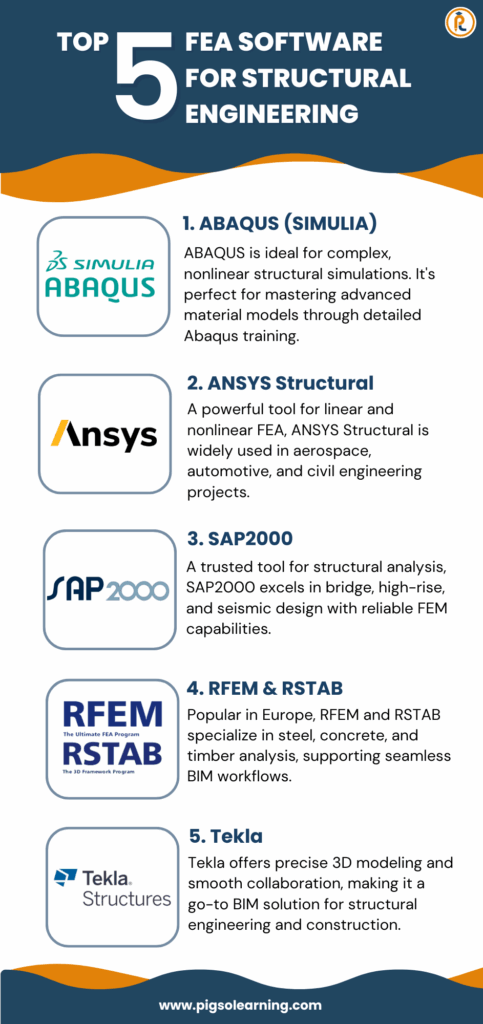- What is finite element analysis in Structural Engineering?
- Applications of Finite Element Analysis in Structural Engineering
- List of Finite Element Analysis Software for Structural Analysis/Engineering
- Advantages of Finite Element Structural Analysis
- Future Trends in Finite Element Analysis for Structural Engineering
- Conclusion
- FAQs
Engineering safety has become the top priority in modern times because structural stability demands critical attention. Engineers use finite element structural analysis software as their most important operational instrument for accomplishing their tasks.
Modern computational techniques have transformed the methods by which professionals predict and enhance structural capabilities. Engineers achieve precise stress and displacement analysis by reducing large, complex structures into small, manageable elements for analysis purposes.
The finite element method in structural engineering functions effectively as an indispensable tool. Let’s dive in.
What is finite element analysis in Structural Engineering?
FESA operates as a numerical approach dedicated to solving engineering problems in structural domains. The methodology divides extensive, complex objects into finite elements that include triangles and quadrilaterals to enable feasible calculations on difficult designs.
The finite element method in structural engineering calculates how structures respond to different physical scenarios.
When different elements share their behavioral responses, the complete structure reacts accordingly with precision. This method enables engineers to detect vulnerable areas and maximize material efficiency while sustaining the structural system’s integrity.
Applications of Finite Element Analysis in Structural Engineering
Finite element analysis and Structural analysis have made it indispensable in most structural engineering sectors. Below are key applications:
1. Building Construction
Structural FEA is important in the building of skyscrapers, bridges, or residential complexes. It enables engineers to validate the material’s load-bearing capacity, adhere to safety standards, and select the best structural design. Finite element structural analysis software is used to find potential weaknesses in design before expensive failures occur.
2. Aerospace & Automotive Structures
FEM structural analysis is mandatory for aerospace and automotive industries to understand how a complex frame behaves under operational stresses. FEA is used by engineers to predict deformation, fatigue, and stress distribution in aircraft bodies, car chassis, and related components to ensure durability and passenger safety.
3. Infrastructure Projects
The structural finite element analysis is the main tool utilized to perform the durability assessments of large-scale infrastructure such as tunnels, bridges, and dams. It helps assess the effect of environmental factors like seismic forces, wind loads, and intense traffic on structural durability for the long term.
4. Offshore & Marine Structures
Extreme conditions also prevail on offshore platforms and marine vessels. In structural engineering, finite element analysis can be used to assess stability and stress concentrations to improve the safety and performance of oil rigs, ships, and other marine infrastructure.
Read more – ABAQUS for Structural Engineering
List of Finite Element Analysis Software for Structural Analysis/Engineering
1. Simulia ABAQUS
ABAQUS functions as an elite finite element analysis (FEA) software to handle advanced structural simulations, especially when dealing with non-linear problems. Welcoming complex material simulations and interactivity, ABAQUS serves industries including the aerospace and automotive fields with biomechanics and manufacturing needs.
Contact problems, together with hyperelastic material and multi-physics simulation capabilities of this software, render it perfect for rubber, composite, and biological tissue simulation applications. The software package comprises ABAQUS/Standard for implicit analysis, together with ABAQUS/Explicit for performing dynamic simulations.
As the ABAQUS developer, Dassault Systèmes offers the manufacturing process platform DELMIA alongside its CAD modeling tool CATIA and its simulation solution SIMULIA. The ABAQUS software enables precise crash test simulations alongside bone fracture analysis while delivering accurate impact assessments for critical engineering uses. If you’re interested in learning ABAQUS from scratch, our ABAQUS Training Course offers hands-on, beginner-friendly lessons for real-world use. Learn Abaqus Structural with our Abaqus Structural Analysis Training.
2. ANSYS Structural
ANSYS Structural functions as both a flexible and forceful solution for addressing linear and nonlinear finite element analysis (FEA) problems. The tool delivers precise results when simulating actual structural behaviors, which explains why industry professionals use it for challenging engineering work. Engineers utilize its nonlinear features to model contact mechanics and material nonlinearities alongside large deformations, which results in reliable structural performance.
ANSYS Structural provides its powerful solver technology across aerospace, automotive, civil, and mechanical engineering industries to enhance design and validation procedures. ANSYS, as the parent corporation, offers customers an elaborate collection of simulation tools, including ANSYS Fluent for fluid dynamics. Learn Ansys with our Ansys Training.
3. SAP2000
SAP2000 functions as an industrial benchmark software application that provides engineers both user-friendly interfaces and enhanced modeling capabilities. Engineering professionals use this adaptive tool to evaluate basic beams and extensive high-rise constructions alongside extensive long-span bridge types.
The infrastructure projects benefit from SAP2000 as an all-in-one analysis platform that supports static, dynamic, and nonlinear analyses. The built-in design attributes within the software accomplish adherence to different international building codes, which guarantee that structures fulfill required standards.
SAP2000 exists as an engineering tool in the CSI product lineup, which also includes ETABS for building analysis, along with SAFE for foundation and slab design. The transportation industry utilizes SAP2000 extensively to understand bridges and analyze earthquake effects and maintain tower stability while providing trustworthy and precise structural data.
4. RFEM & RSTAB
RSTAB, together with RFEM, represents Europe’s most common structural analysis platforms, which provide users with advanced functionality and user-friendly interfaces. The finite element modeling capabilities of RFEM enable efficient analysis for structures including high-rise buildings, industrial plants, and stadiums.
RSTAB shows specific optimization for analyzing beams and frames, especially when working with steel and timber projects. These software platforms support the design and analysis of steel as well as concrete, timber, aluminum, and membrane structures.
5. Tekla
The Trimble company created the Building Information Modeling (BIM) software Tekla for applications in construction and structural engineering scenarios. The software helps users create precise models of steel and concrete buildings for the complete construction sequence from design planning to fabrication work and erection activities.
The detailed 3D models in Tekla help engineers spot component clashes and reduce errors while enhancing project coordination. The software integrates with other tools to enable seamless teamwork between architects, engineers, and contractors.
Large-scale infrastructure projects benefit greatly from Tekla because it ensures both structural integrity and efficiency. Tekla acts as an essential tool that enables both precision improvements and workflow optimization to deliver premium construction results that meet deadlines while staying under budget.
Advantages of Finite Element Structural Analysis
The benefits of finite element structural analysis software have generated enthusiasm among users because of its numerous benefits:
1. Accuracy & Precision
Engineers analyze complex geometry by slicing it up into finite elements, improving their understanding of stress concentrations, deformation patterns, and failure points.
2. Cost-Efficiency
Virtual tests through structural finite element analysis eliminate the need for expensive prototypes and physical testing.
3. Versatility
The finite element method in structural engineering has been applied to a large variety of materials, structures, and loading conditions.
4. Time Savings
It speeds up project timetables by allowing engineers to quickly modify models, rerun analyses, and do other such things.
5. Risk Mitigation
FEM structural analysis enables a prediction of structural vulnerabilities before the construction begins. It also enhances safety standards and prevents unaffordable post-construction repairs.
Future Trends in Finite Element Analysis for Structural Engineering
New technology continues to advance the field of finite element analysis in structural engineering. Here are some notable future trends:
1. Integration with AI & Machine Learning
Engineers will soon be using AI-driven optimization to identify the most efficient designs given past analysis data, improving decision-making.
2. Cloud-Based Structural FEA Software
Nowadays, more structural FEA software providers are going with the cloud to provide easier scalability, collaboration, and remote access of complex simulations.
3. Real-Time Structural Health Monitoring
Real-time assessment will be enabled by combining finite element structural analysis with existing structures’ sensor data, improving maintenance and safety.
4. Enhanced Material Modeling
Future software updates will build new generation materials simulating smart composites to satisfy 21st-century engineering needs.
Conclusion
Finite element structural analysis transformed structural engineering by delivering exact solutions that combine efficiency with safety protocols. Every engineer relies on the finite element method for structural applications because of its ability to handle diverse projects while maintaining exceptional reliability.
Finite element analysis structural analysis software helps professionals accurately forecast performance outcomes and reduce risks, as well as drive new technical advancements.
Structural finite element analysis will drive greater importance as technological developments shape future structures because they guarantee safer and smarter buildings worldwide. Explore more engineering insights and training programs with PIGSO LEARNING to stay ahead in structural engineering advancements.
FAQs
1. What is structural engineering’s finite element analysis (FEA)?
Finite Element Analysis (FEA) is a computational approach to simulate and evaluate structural behavior under different loads to ensure the safety and efficiency of the design.
2. What is the Finite Element Method (FEM) in structural analysis?
The Finite Element Method (FEM) is a numerical technique to solve the problem of complex structure by dividing it into smaller elements for analyzing the stress, strain, and deformation.
3. Can FEA be Used in the Field of Engineering?
Structural FEA is used to predict how buildings, bridges, and other structures will behave under the force of gravity, wind, and seismic activity.
4. Which Are Some of the Most Popular Structural FEA Software?
SIMULIA Abaqus, COMSOL Multiphysics, Ansys Mechanical, Altair HyperWorks, and Tekla Structural Designer are the most popular FEA software listed, which are known for structural analysis. You can perform structural analysis according to their industry products.
5. What is so important about finite element structural analysis?
Structural analysis of solids using finite elements enhances structural designs, reduces the use of material, and ensures the system complies with safety regulations.
I’m a passionate content writer who crafts compelling, audience-focused content. I specialize in turning ideas into engaging words, ensuring every piece delivers value, connects, and drives results.










